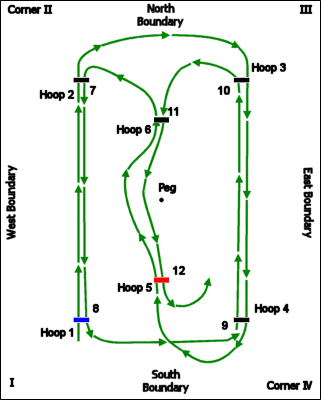
Golf Croquet Synopsis
 The course and lawn bearings
The course and lawn bearings
The opposing sides each have two balls: Blue and Black against Red and Yellow. Each side may be one or two people (i.e. singles or doubles). Each side plays alternately in rotation: blue, red, black, yellow, as shown by the sequence of colours from the top of the centre peg.
Each turn consists of one stroke only: no extra stoke is gained by running a hoop or hitting another ball (unlike Association Croquet). To start the game, toss a coin. The winner of the toss chooses whether to play first or second. The side that plays first plays blue and black, and blue always starts.
The opening strokes are played from within one yard of Corner IV (nearest hoop 4), and the players aim to run the hoops in order from 1 to 12. The winner is the first to reach 7 points. A deciding hoop (hoop 3 again) is run if the scores are equal after 12 hoops, making 13 in all.
To score a point, a ball must run completely through the hoop in the correct direction. In marginal situations, a ball has run a hoop if none of the ball is visibly protruding from the playing side of the hoop. It may run the hoop in more than one turn, or be knocked through by another ball. If a ball should go through two hoops in order in the same stroke, both points are scored.
The side that first gets a ball through Hoop 1 scores that point and then all balls go for the next hoop in order (i.e. Hoop 2). All players contest the same hoop. A player may play towards the next hoop before the previous hoop is run. However, subject to certain exceptions set out in the detailed Rules, the opponents may ask that any ball more than halfway towards the next hoop when the current hoop is actually run, is brought back to a penalty area halfway down the east or west boundaries.
A ball that goes off the court is replaced on the boundary where it went off but may be temporarily moved if it interferes with the playing of another ball.
The striking of the ball in a turn must be a clean, single hit; there are a number of faults that a player may make when striking the ball. These are listed in the detailed rules. After a fault, the non-offending side chooses whether to leave the balls where they lie or to have all balls replaced in their positions before the faulty stroke. The non-offending side then plays their next ball in sequence.
If a player plays out of sequence the error is remedied in one of two ways. Either the balls are replaced and the player then plays the correct ball or by a ball swap when the balls are left where they finished except that the positions of the ball just played and its partner ball are swapped. Players should stop play if they believe that a wrong ball is about to be played or has just been played. See the Wrong Ball rule in the detailed Rules.
To allow evenly contested games between players of different abilities either the weaker player is given a number of extra strokes or the starting scores are adjusted. See the rules on Handicap Play and Advantage Play in the detailed Rules.
Further details:
- Simplified Basic Rules Of Golf Croquet.
- The full Rules of Golf Croquet.
- The Croquet England Shop supplies various publications for both beginners and more advanced players, including a Rules booklet.
See also:



 Using this website
Using this website

